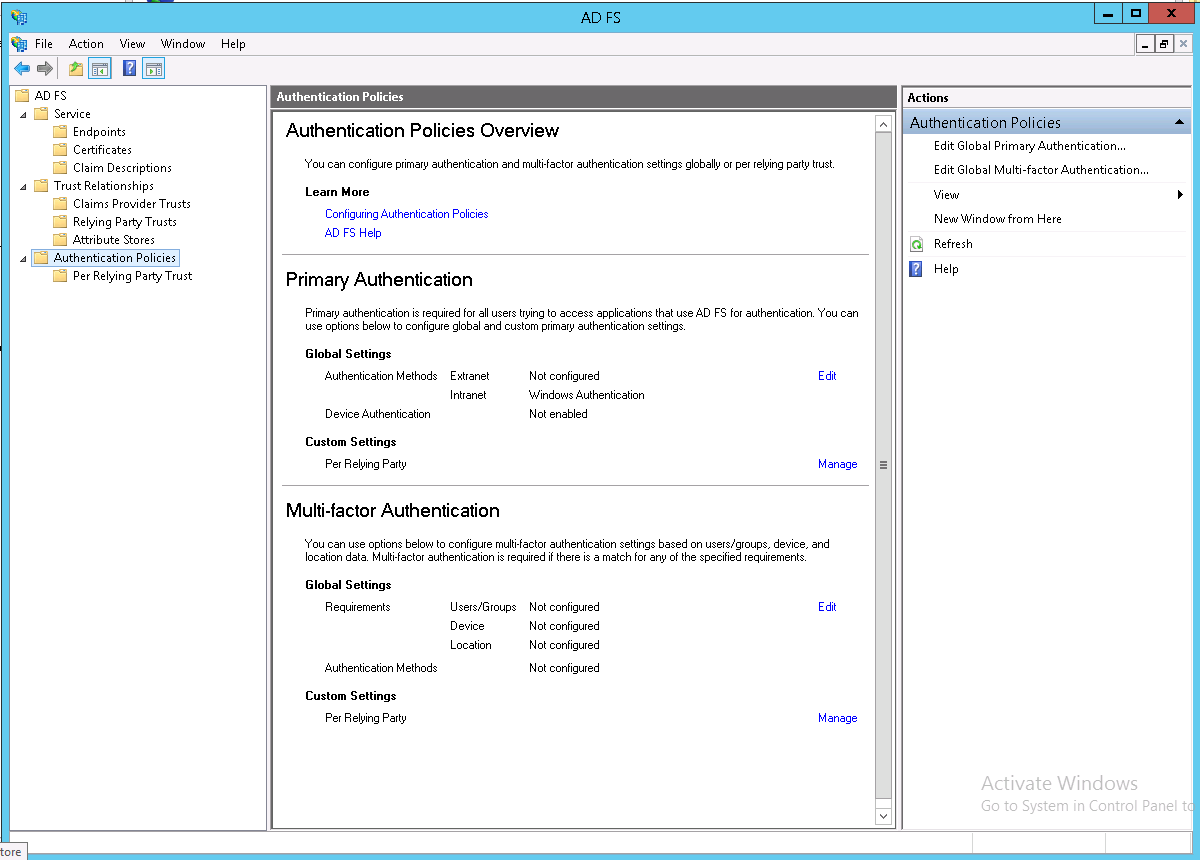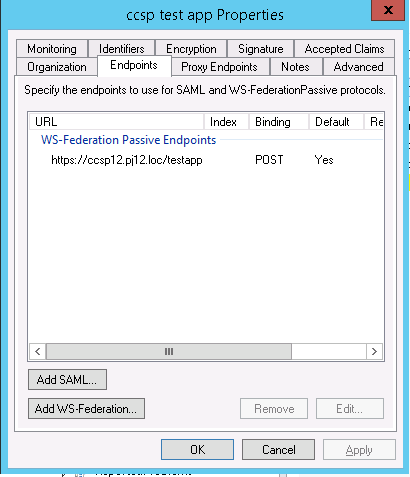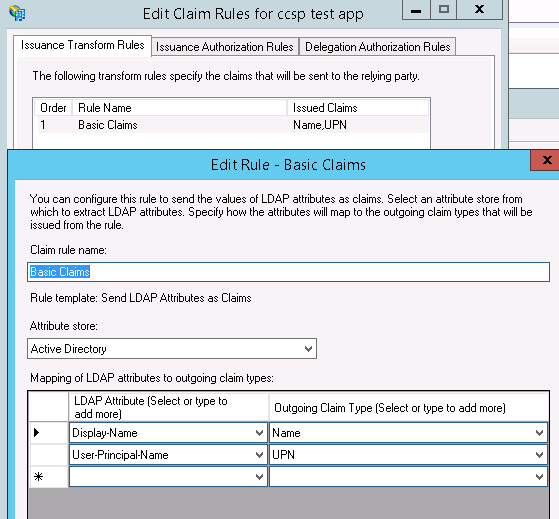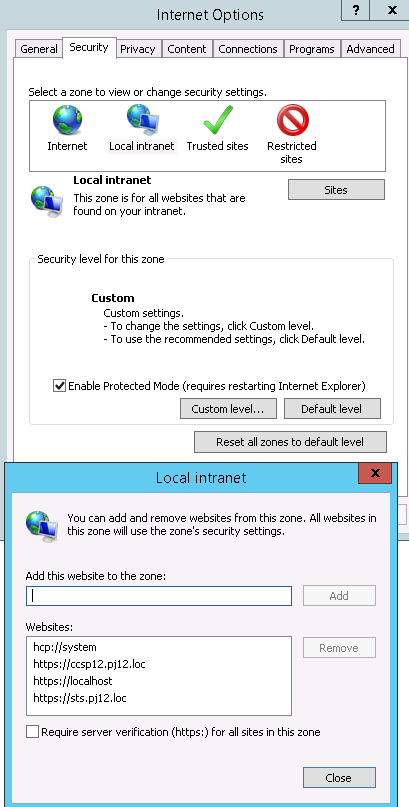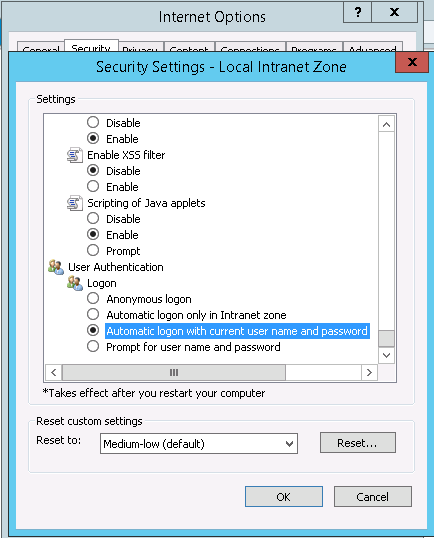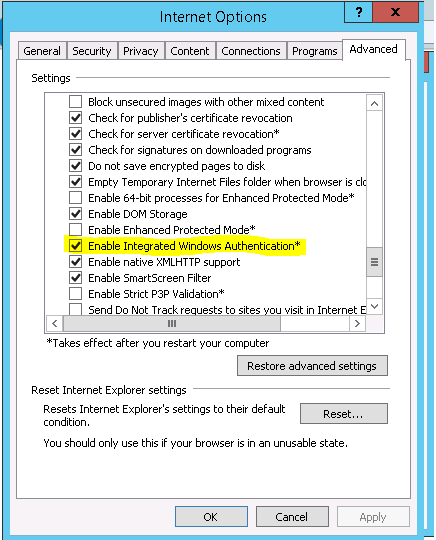Встроенная проверка подлинности Windows SSO SAML ADFS не работает
проект, над которым мы сейчас работаем, - это единый вход через ADFS с использованием токена SAML.
основное правило этого проекта должно следовать следующее:
1. Агент входит в windows, используя свои учетные данные.
2. Агент входит в веб-приложение (проверяющая сторона)
3. Веб-приложение должно перенаправить STS в ADFS (Active Directory-поставщик удостоверений) и войти в систему, используя учетные данные, используемые агентом в его ее windows аутентификация (бесшовная аутентификация).
4. Поэтому страница входа в STS не должны отображаться и пользователь должен быть аутентифицирован
5. После этого претензии и маркер безопасности должны быть получены для того, чтобы авторизовать агент
Фактический Результат:
1. Перенаправление выполняется впервые, и аутентификация требуется снова (т. е. страница аутентификации и аутентификация FirefoxChrome страница.)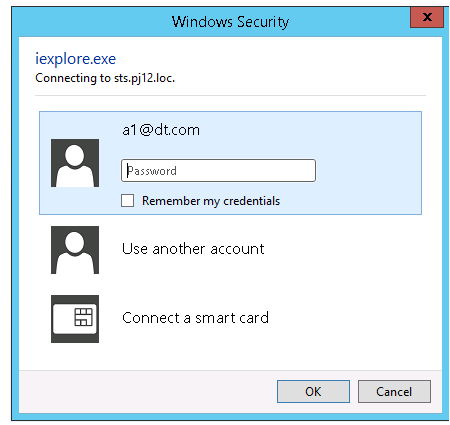

- может выполнять аутентификацию со всеми пользователями домена, а не только с пользователем, прошедшим проверку подлинности windows.
- после первого входа на страницу входа sts аутентификация не требуется снова. Однако мы не хотим второй аутентификации. Только при входе в систему windows (true только для IE).
Настроенной Среды:
1. Контроллер домена + ADFS сервер 3.0 на той же машине (Win2k12R2)
2. Машины веб-приложений (Win2k12 + IIS8.5)
3. Машины находятся в одном домене
конфигурация ADFS:
Конфигурация Проверяющей Стороны:
Конфигурация Веб-Приложения:
Проверка подлинности:
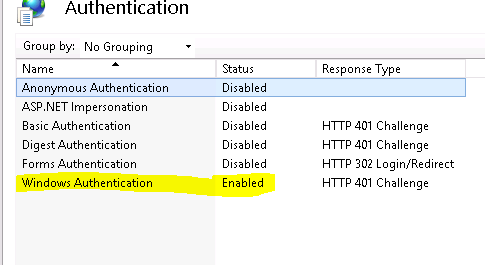 ASP.Net Проект:
ASP.Net Проект:
Файл Веб-Конфигурации:
<?xml version="1.0" encoding="utf-8"?>
<!--
For more information on how to configure your ASP.NET application, please visit
http://go.microsoft.com/fwlink/?LinkId=169433
-->
<configuration>
<configSections>
<!-- For more information on Entity Framework configuration, visit http://go.microsoft.com/fwlink/?LinkID=237468 -->
<section name="entityFramework" type="System.Data.Entity.Internal.ConfigFile.EntityFrameworkSection, EntityFramework, Version=5.0.0.0, Culture=neutral, PublicKeyToken=b77a5c561934e089" requirePermission="false" />
<section name="system.identityModel" type="System.IdentityModel.Configuration.SystemIdentityModelSection, System.IdentityModel, Version=4.0.0.0, Culture=neutral, PublicKeyToken=B77A5C561934E089" />
<section name="system.identityModel.services" type="System.IdentityModel.Services.Configuration.SystemIdentityModelServicesSection, System.IdentityModel.Services, Version=4.0.0.0, Culture=neutral, PublicKeyToken=B77A5C561934E089" />
</configSections>
<connectionStrings>
<add name="DefaultConnection" providerName="System.Data.SqlClient" connectionString="Data Source=(LocalDb)v11.0;Initial Catalog=aspnet-TestApp-20150730141753;Integrated Security=SSPI;AttachDBFilename=|DataDirectory|aspnet-TestApp-20150730141753.mdf" />
</connectionStrings>
<location path="FederationMetadata">
<system.web>
<authorization>
<allow users="*" />
</authorization>
</system.web>
</location>
<system.web>
<authorization>
<deny users="?" />
</authorization>
<authentication mode="None" />
<compilation debug="true" targetFramework="4.5" />
<httpRuntime targetFramework="4.5" />
<pages>
<namespaces>
<add namespace="System.Web.Optimization" />
</namespaces>
<controls><add assembly="Microsoft.AspNet.Web.Optimization.WebForms" namespace="Microsoft.AspNet.Web.Optimization.WebForms" tagPrefix="webopt" /></controls></pages>
<!--<authentication mode="Forms">
<forms loginUrl="~/Account/Login" timeout="2880" defaultUrl="~/" />
</authentication>-->
<profile defaultProvider="DefaultProfileProvider">
<providers>
<add name="DefaultProfileProvider" type="System.Web.Providers.DefaultProfileProvider, System.Web.Providers, Version=1.0.0.0, Culture=neutral, PublicKeyToken=31bf3856ad364e35" connectionStringName="DefaultConnection" applicationName="/" />
</providers>
</profile>
<membership defaultProvider="DefaultMembershipProvider">
<providers>
<add name="DefaultMembershipProvider" type="System.Web.Providers.DefaultMembershipProvider, System.Web.Providers, Version=1.0.0.0, Culture=neutral, PublicKeyToken=31bf3856ad364e35" connectionStringName="DefaultConnection" enablePasswordRetrieval="false" enablePasswordReset="true" requiresQuestionAndAnswer="false" requiresUniqueEmail="false" maxInvalidPasswordAttempts="5" minRequiredPasswordLength="6" minRequiredNonalphanumericCharacters="0" passwordAttemptWindow="10" applicationName="/" />
</providers>
</membership>
<roleManager defaultProvider="DefaultRoleProvider">
<providers>
<add name="DefaultRoleProvider" type="System.Web.Providers.DefaultRoleProvider, System.Web.Providers, Version=1.0.0.0, Culture=neutral, PublicKeyToken=31bf3856ad364e35" connectionStringName="DefaultConnection" applicationName="/" />
</providers>
</roleManager>
<!--
If you are deploying to a cloud environment that has multiple web server instances,
you should change session state mode from "InProc" to "Custom". In addition,
change the connection string named "DefaultConnection" to connect to an instance
of SQL Server (including SQL Azure and SQL Compact) instead of to SQL Server Express.
-->
<sessionState mode="InProc" customProvider="DefaultSessionProvider">
<providers>
<add name="DefaultSessionProvider" type="System.Web.Providers.DefaultSessionStateProvider, System.Web.Providers, Version=1.0.0.0, Culture=neutral, PublicKeyToken=31bf3856ad364e35" connectionStringName="DefaultConnection" />
</providers>
</sessionState>
</system.web>
<system.webServer>
<modules>
<!--<add name="WSFederationAuthenticationModule" type="System.IdentityModel.Services.WSFederationAuthenticationModule, System.IdentityModel.Services, Version=4.0.0.0, Culture=neutral, PublicKeyToken=b77a5c561934e089" preCondition="managedHandler" />-->
<add name="FixedWSFederationAuthenticationModule" type="TestApp.FixedWSFederationAuthenticationModule, TestApp" preCondition="managedHandler" />
<add name="SessionAuthenticationModule" type="System.IdentityModel.Services.SessionAuthenticationModule, System.IdentityModel.Services, Version=4.0.0.0, Culture=neutral, PublicKeyToken=b77a5c561934e089" preCondition="managedHandler" />
</modules>
</system.webServer>
<system.identityModel>
<identityConfiguration saveBootstrapContext="true">
<!-- The identity configuration. No name means default configuration which is always used for passive federation scenarios. see federationConfiguration element -->
<audienceUris>
<add value="https://ccsp12.pj12.loc/testapp" />
</audienceUris>
<issuerNameRegistry type="System.IdentityModel.Tokens.ConfigurationBasedIssuerNameRegistry, System.IdentityModel, Version=4.0.0.0, Culture=neutral, PublicKeyToken=b77a5c561934e089">
<trustedIssuers>
<add thumbprint="91992FCF8B03FF9BD98A259FE93B92620E9DD89A" name="http://sts.pj12.loc/adfs/services/trust" />
</trustedIssuers>
</issuerNameRegistry>
<certificateValidation certificateValidationMode="None" />
</identityConfiguration>
</system.identityModel>
<system.identityModel.services>
<federationConfiguration> <!-- Configures the WSFederationAuthenticationModule (WSFAM) and the SessionAuthenticationModule (SAM) when using federated authentication through the WS-Federation protocol -->
<cookieHandler requireSsl="false" />
<!-- passiveRedirectEnabled true means that a relaying party (test app) instead of having its own login page, it will redirect to the sts issuer for authentication and the sts will reply to the relaying party -->
<!-- Due to WSFederationAuthenticationModule bug, the relaying party address must be with '/' at the end -->
<wsFederation passiveRedirectEnabled="true" issuer="https://sts.pj12.loc/adfs/ls/" realm="https://ccsp12.pj12.loc/testapp/" reply="https://ccsp12.pj12.loc/testapp/" requireHttps="true" />
</federationConfiguration>
</system.identityModel.services>
<!--<runtime>
<assemblyBinding xmlns="urn:schemas-microsoft-com:asm.v1">
<dependentAssembly>
<assemblyIdentity name="DotNetOpenAuth.Core" publicKeyToken="2780ccd10d57b246" />
<bindingRedirect oldVersion="1.0.0.0-4.0.0.0" newVersion="4.1.0.0" />
</dependentAssembly>
<dependentAssembly>
<assemblyIdentity name="DotNetOpenAuth.AspNet" publicKeyToken="2780ccd10d57b246" />
<bindingRedirect oldVersion="1.0.0.0-4.0.0.0" newVersion="4.1.0.0" />
</dependentAssembly>
</assemblyBinding>
</runtime>-->
<entityFramework>
<defaultConnectionFactory type="System.Data.Entity.Infrastructure.SqlConnectionFactory, EntityFramework" />
</entityFramework>
</configuration>
C# Код:
namespace TestApp
{
public partial class _Default : Page
{
protected void Page_Load(object sender, EventArgs e)
{
// local variables
string claimsTypes = string.Empty;
string claimsValues = string.Empty;
string claimsValueTypes = string.Empty;
string claimsSubjectNames = string.Empty;
string claimsIssuers = string.Empty;
// initialize claims and identity
ClaimsPrincipal claimsPrincipal = Thread.CurrentPrincipal as ClaimsPrincipal;
ClaimsIdentity claimsIdentity = Thread.CurrentPrincipal.Identity as ClaimsIdentity;
BootstrapContext bootstrapContext =
ClaimsPrincipal.Current.Identities.First().BootstrapContext
as BootstrapContext;
if (claimsPrincipal != null)
{
signedIn.Text = "You are signed in.";
foreach (Claim claim in claimsPrincipal.Claims)
{
claimsTypes = string.Concat(claimsTypes, "; ", claim.Type);
claimsValues = string.Concat(claimsValues, "; ", claim.Value);
claimsValueTypes = string.Concat(claimsValueTypes, "; ", claim.ValueType);
claimsSubjectNames = string.Concat(claimsSubjectNames, "; ", claim.Subject.Name);
claimsIssuers = string.Concat(claimsIssuers, "; ", claim.Issuer);
}
//claims principals
claimType.Text = claimsTypes;
claimValue.Text = claimsValues;
claimValueType.Text = claimsValueTypes;
claimSubjectName.Text = claimsSubjectNames;
claimIssuer.Text = claimsIssuers;
// ClaimsIdentity
isUserAuthenticated.Text = claimsIdentity.IsAuthenticated.ToString();
authenticationType.Text = claimsIdentity.AuthenticationType;
claimName.Text = claimsIdentity.Name;
// Token
// known bug : http://stackoverflow.com/questions/13514553/wif-4-5-bootstrapcontext-security-token-null
SecurityToken token = null;
if (bootstrapContext.SecurityToken != null)
{
token = bootstrapContext.SecurityToken;
}
else if (!bootstrapContext.Token.Equals(string.Empty))
{
var handlers = FederatedAuthentication.FederationConfiguration.IdentityConfiguration.SecurityTokenHandlers;
token = handlers.ReadToken(new XmlTextReader(new StringReader(bootstrapContext.Token)));
}
SamlSecurityToken sst = token as SamlSecurityToken;
tokenId.Text = sst.Id;
tokenAssertionId.Text = sst.Assertion.AssertionId;
tokenIssuer.Text = sst.Assertion.Issuer;
}
else
{
signedIn.Text = "You are not signed in.";
}
}
}
любая помощь будет оценили.
1 ответов
наконец, я смог достичь бесшовной Windows интегрированной SSO !
Я нашел некоторое свойство ADFS под названием "WIASupportedUserAgents". Это означает: поддерживаемые браузеры, разрешенные для WIA (встроенная проверка подлинности Windows).
В PowerShell выполняется следующее:
Set-ADFSProperties -WIASupportedUserAgents @("MSIE 6.0", "MSIE 7.0", "MSIE 8.0", "MSIE 9.0", "MSIE 10.0", "MSIE 11.0", "Trident/7.0", "MSIPC", "Windows Rights Management Client", "Mozilla/5.0")
чем перезапустить службу ADFS.
после установки этого свойства для всех браузеров поддержки, бесшовная проверка подлинности Windows SSO начал работать !
Я не понимаю ... окно учетных данных и аутентифицированный пользователь windows автоматически аутентифицируются через ADFS.
работает как шарм.
спасибо всем и особенно Виктору Зыхле за его большое желание помочь !

